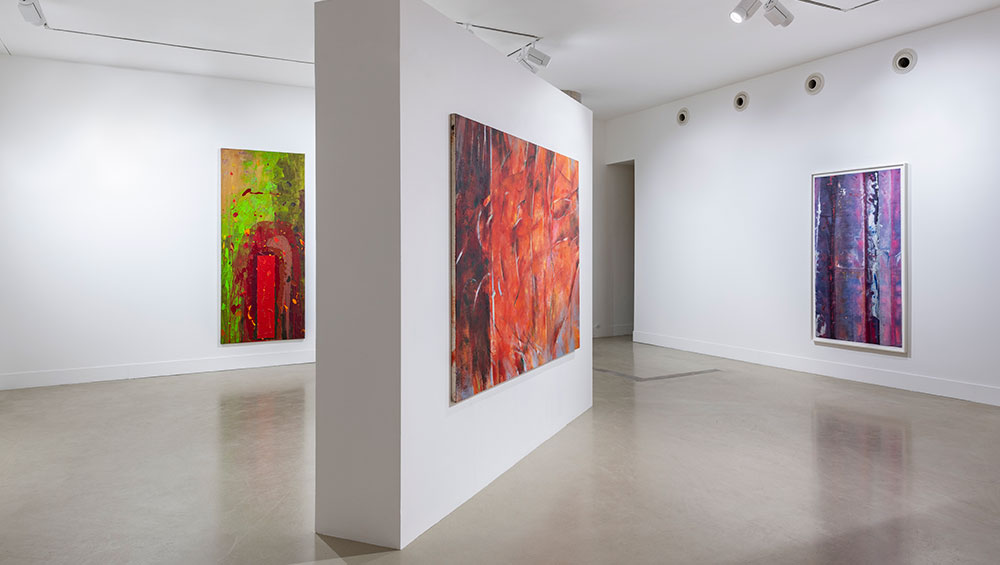
Modal Painting, installation view, Maximillian William, London, Spring 2021. Photo: Damian Griffiths. Image courtesy of Maximillian William, London.
Maximillian William Gallery, London
12 April – 2 May 2021
by VERONICA SIMPSON
“Paintings are there to be experienced, they are events. They are also to be meditated on and to be enjoyed by the senses; to be felt through the eye.” This quote, from the London-based, Sheffield-born artist John Hoyland (1934-2011) says it all, I decide, as I encounter the first real, live show of real, live paintings in a gallery setting for nearly four months, following the UK’s most severe and lengthy period of coronavirus restrictions. Hoyland’s work pulses across the concrete floor of this slick, compact space. Titled 4.3.70 (1970), it comprises an assemblage of splashes and smears in phosphorescent green and bloody burgundy and red; the thick, vertical stripe of vermilion at its base is the only reminder of the spare, abstract painting for which Hoyland became famous in the 60s, after he first visited the US, and fell in with Robert Motherwell, Barnett Newman and Mark Rothko. As the monograph on Hoyland – thoughtfully placed nearby on a gallery bench and in which I find the above quote – attests, minimalist geometries didn’t hold him for long.
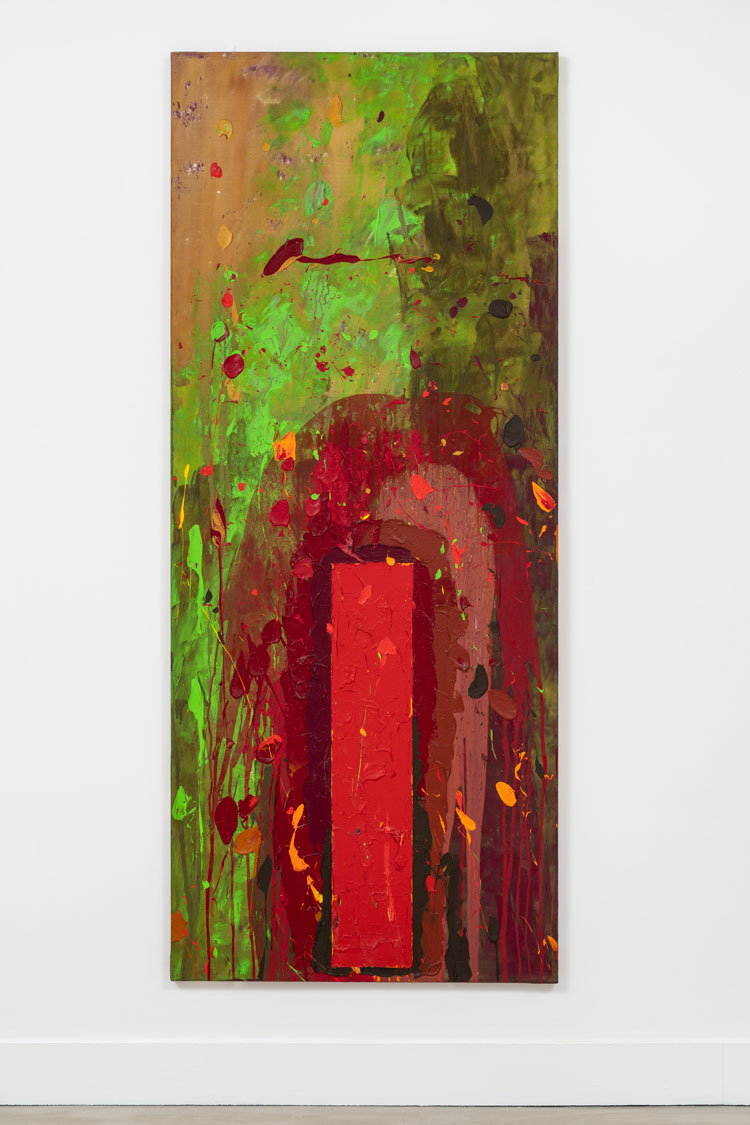
John Hoyland. 4.3.70, 1970. Acrylic on canvas, 243.8 × 101.6 cm (96 × 40 in). Photo: Damian Griffiths. © Estate of John Hoyland. All rights reserved, DACS 2021 Image courtesy of Maximillian William, London.
Hoyland’s contemporary, Frank Bowling (b1934, Guyana), is placed in conversation with him here, with his Plume (1978) painting situated opposite, on the short, diagonal wall panel that bisects this room. It offers a celestial blue “presence” at the centre of the painting, feathering into pinks and yellows as it journeys outwards, accompanied by splotchy ochre circles surrounded by their own inky blue aura. Bowling’s practice began with an intensely personal and political, figurative approach.
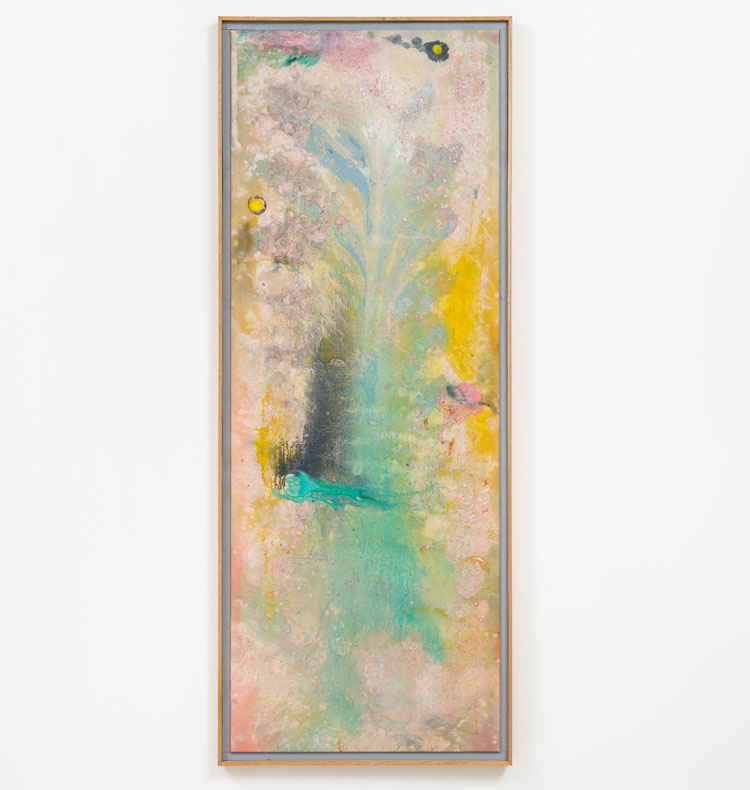
Frank Bowling. Plume, 1978. Acrylic on canvas, 184 x 72 x 4.3 cm (72.4 x 28.3 x 1.7 in). Photo: Damian Griffiths. © Frank Bowling and Hauser & Wirth. Courtesy of Private Collection, London. All Rights Reserved, DACS 2021.
For him, too, a visit to New York in the 60s was pivotal, freeing up his style and palette to create his characteristic cosmic drifts of acrylic paint, powder, chalk, glitter, gel, ammonia and crushed or scattered detritus through an intensely experimental process.
And it is the processes of Hoyland and Bowling and the three other selected artists that intrigue curator and artist Oscar Wollheim. Along with Reginald Sylvester II (b1987, North Carolina), Sam Gilliam (b1933, Tupelo Mississippi) and the British-born John Golding (1929-2012), they are all firmly (even if only recently in Sylvester’s case) embedded in the abstract genre, but it is how they arrive at their abstractions – the emotional, physical, visceral and intellectual DNA of their practice – that intrigues Wollheim.
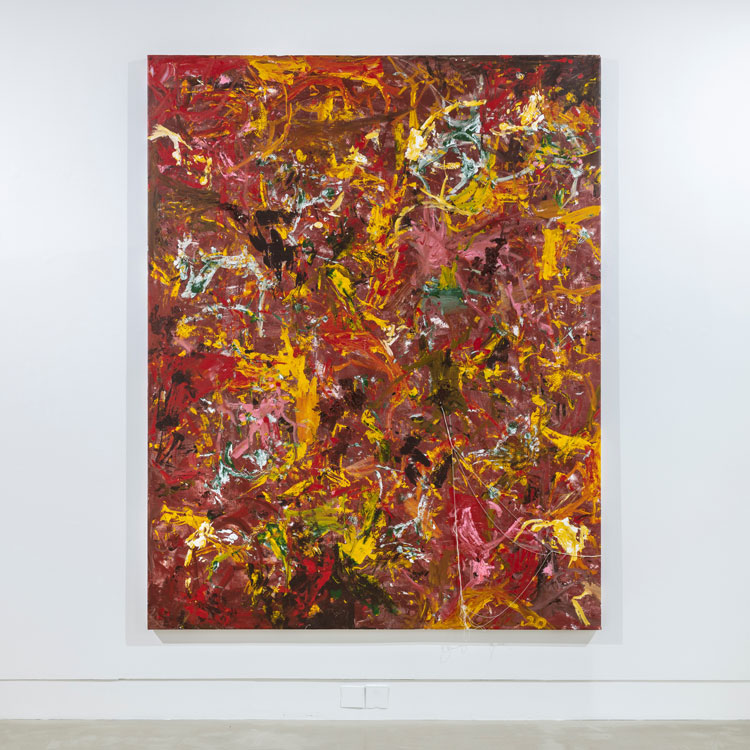
Reginald Sylvester II. Rise Young Gods All Paths Lead to Lazarus, 2020. Acrylic on canvas,
235 x 185.4 cm (92.5 x 73 in). Photo: Damian Griffiths. © Reginald Sylvester II. Image courtesy of the artist and Maximillian William, London.
Sylvester was born long after the other artists here, nearly 60 years after Golding, whose simple, coloured planes of the 70s turned into looser, more expressive works in the 80s. Golding’s work here, J.21 (Bibemus) is from 1991. The warm hues emanating from this large canvas – placed behind Bowling’s on the aforementioned free-standing diagonal wall panel – are entirely welcome on a chilly, spring London day. Sumptuous sections of saffron and pomegranate with scattered bursts of orange emerge from darker, burgundy contouring, cross-hatched by pale dashes that imply movement, speed, flashes of light. This blast of tropical energy couldn’t have happened had not Golding, who was born in Hastings, by the bleak British seaside, not been immersed as a child and young man in the landscapes and light of Mexico. Sylvester also spent formative years – albeit more recently - as a young artist south of the US border, a period that is said to have transformed his materials and his understanding of process, resulting in, according to Wollheim, far richer and more immersive paintings. Sylvester’s current abstract explorations are exemplified by the work on show here: Rise Young Gods All Paths Lead to Lazarus (2020), which features one of Sylvester’s now signature dangling threads, salvaged from his studio floor.
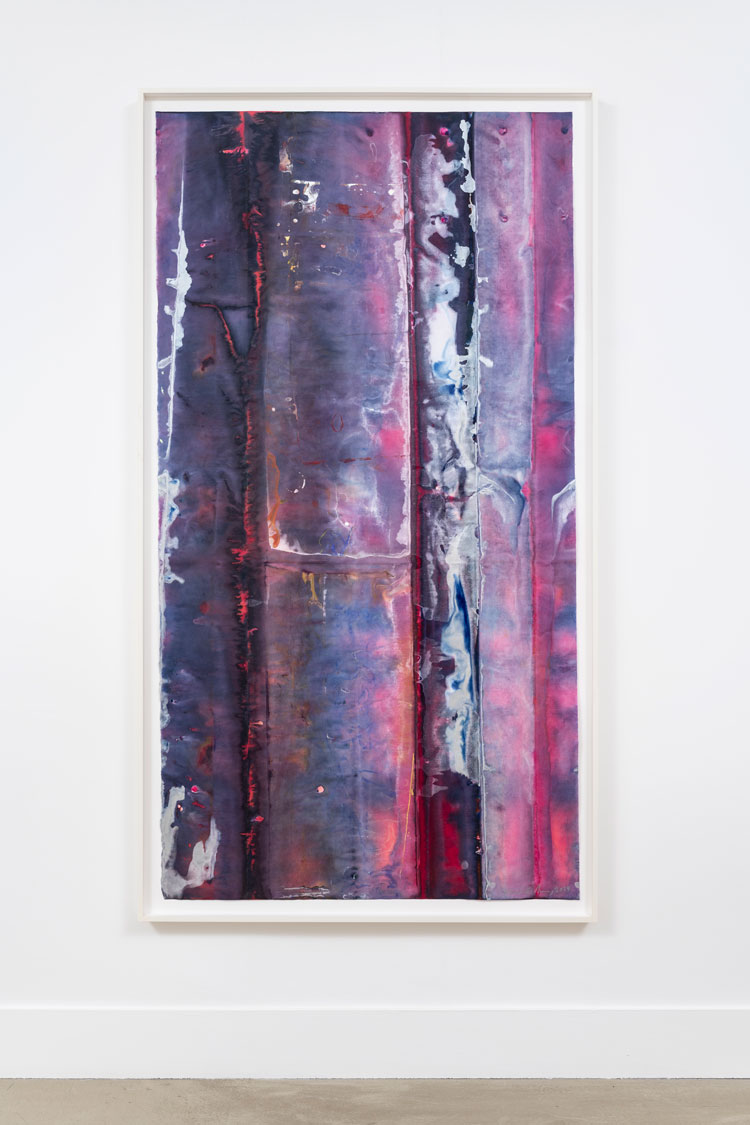
Sam Gilliam. Untitled, 2019. Watercolour and acrylic on washi paper, 194 × 107 × 5.7 cm (76.4 × 42.1 × 2.3 in). Photo: Damian Griffiths. © Sam Gilliam, ARS, NY and DACS, London 2021. Image courtesy of Private Collection, Europe and Maximillian William, London.
There are multiple threads connecting these five artists - way more than their choice of abstraction. It is quite something to try to convey that with only one work apiece. But Sylvester, Bowling and Gilliam have, arguably, the most significant thing in common: they are black artists making abstract work, going against the grain of their own (and at times the art world’s) prevailing culture and norms. However, this narrative was not in the foreground as he conceived this show, says Wollheim: “Fundamentally the idea of the show was never to base it around black abstract painters. That was never the context or the object of the show. I have been in dialogue, through the gallery, with Reginald Sylvester for quite a while and seeing him emerge quite recently from figurative into abstract painting, that was one of the places out of which the show began to form. His emergence into abstract painting made him think, as well as me, about the role that Gilliam and Bowling had played at a moment when it was a completely different environment for black artists, black painters to be abstract. When they were starting to embrace it, there was a lot of hostility and resistance towards the idea of black painters painting abstract because most of the black painting movement then was based figuratively and was explicitly political. Abstract painting was seen in some way as escapist or a rejection of politics or the concerns of being black at that time. So I think they really forged that space to say it can be relevant. Black painters have just as much freedom to paint in the abstract and have similar concerns. That’s very relevant now to Reginald. But there are still many more black painters who paint figuratively … There are similarities between the moment now and then, even if there isn’t the same hostility.”
-1991-3.jpg)
John Golding. J. 21 (Bibemus), 1991. Acrylic on canvas, 162.5 x 224 cm (64 x 88.1 in). Photo: Damian Griffiths. © John Golding Artistic Trust, London. Image courtesy of the Trust and Maximillian William, London.
For the older artists, it seems their work has thrived in the current cultural mood swing, to embrace all things painterly, and their popularity reflects the broadening of cultural bandwidths to ensure that we have a much wider, healthier perspective on who art is made by and for.
However, in that light, it seems a shame that where the racial balance is exemplary, there is not one woman artist that the curator thought to place here. Putting this point to Wollheim, he says: “We’re looking to expand the show to Los Angeles. We’ll have a bigger space to show more artists and I would be looking to include female abstract painters, hopefully both contemporary and of a similar age. Helen Frankenthaler (1928-2011) might have an interesting part to play in the dialogue, in terms of the fluidity of her process, and Pat Lipsky (b1941, New York), too, with her looser works. But I really didn’t choose the artists because they happened to be black or men. They formed together organically. The first point of approach was aesthetic and for some artists there was more to select from than others. What we were able to pull together has worked out really well. It has worked out for me personally as a true expression of the original idea, they speak to each other nicely. It was really exciting doing the install, I was seeing most of them in the flesh for the first time, we were seeing their connections in new ways.”
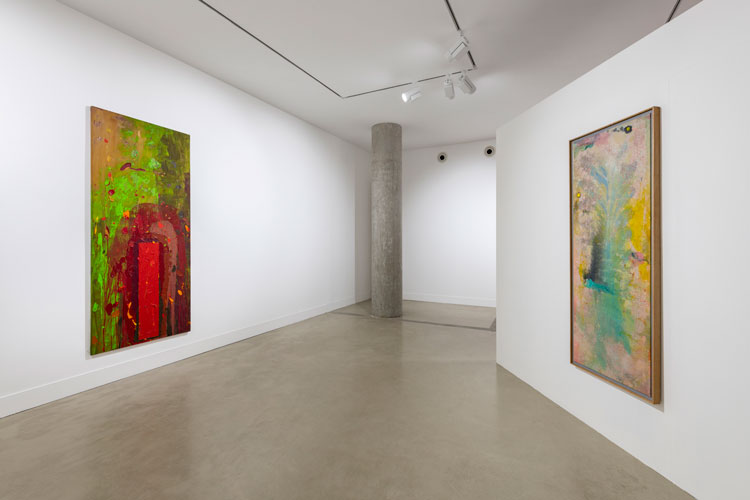
Modal Painting, installation view, Maximillian William, London, Spring 2021. Photo: Damian Griffiths. Image courtesy of Maximillian William, London.
As a celebration of the visceral, sensual joy of painting, this show certainly packs a punch, despite its brevity. For deeper insights into the artists’ process, it is well worth viewing a filmed conversation (freely available on the gallery’s website, on Vimeo) between Wollheim, Sylvester, and Bowling’s son, Ben Bowling, a criminologist by profession, but also frequently drafted in as assistant to his father. He says: “For Frank the subject matter of painting is paint. Even though there is the figure, there is landscape, there is, if you like, substantive subject matter; for him, the subject is paint. What he’s trying to do is express ideas, thoughts, in the language of paint, expressed in colour and the way colours mix together.”
But Ben Bowling really nails the everlasting joy of artistic creation when he likens abstract painting to jazz: “There’s a structure, there’s a geometry, there’s a palette, there’s materials, but then there’s improvisation, which somehow pulls everything together to create some kind of complex unity.”